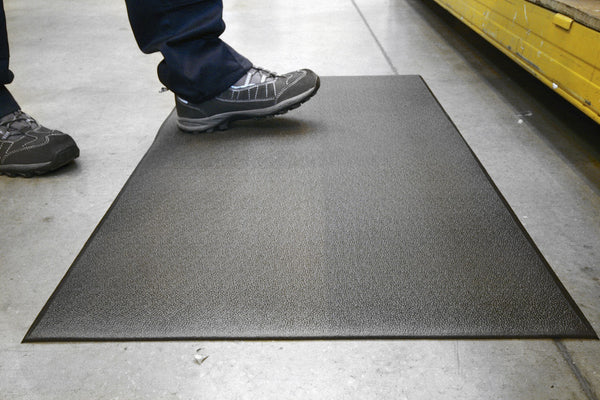MatMan
Member
Many workshop owners will be familiar with the pains caused by prolonged standing, including back ache and foot pains. Fortunately, anti-fatigue matting can be used to help reduce the pain and improve comfort while working with your machinery. But with so many options out there, how do you know which type of matting is best for your needs? This short article will help to explain the different types of matting and allow you to make an informed decision when purchasing matting for your workshop.
Styles
First, let’s look at the different styles of mats. The different designs available all have different benefits.
Ring Mat – Usually made from natural rubber, the ring style of mat is designed primarily as a swarf mat, capturing machining swarf from the base of your shoes and containing them within the mat area. These are great where metal and wood swarf are being traipsed around the building, or where the floors around the machine become wet as they are effective at reducing slips.

Textured top – Some mats have a solid surface with a coin pattern or raised fingers. These are great at scraping softer swarf from feet (such as in food production areas) and the textured surface provides better grip than a flat top version.

Flat/Solid top – For most dry workshops, a flat top anti-fatigue mat will be the ideal choice. These are ideal in areas that are primarily dry such as assembly areas. Lower cost mats, whilst still beneficial, can be quite thin so if the mat will get regular use then a slightly thicker more expensive option would be worth considering.

Materials
Once you know which style of mat you need, the next consideration is the materials.
Rubber – Most anti-fatigue mats for workshops are made from natural rubber. This is a good, cost-effective material providing a soft surface to stand on and protection from slips. Natural rubber does not offer good resistance to oils, so should only be used in dry areas or where the only liquid is water based.
Nitrile – In workshops where the mat will come into regular contact with oil, Nitrile will be the best material to use as it will not absorb the oil so offers a much better lifespan. Nitrile mats are often sold in a blue colour to help differentiate them from Natural Rubber versions.
Foam – As an alternative to rubber, anti-fatigue mats are often constructed with a foam centre. This can provide a much softer surface to stand on than rubber, but care should be taken to ensure the correct foam mat is being used. Some of them are made in a closed-cell construction, meaning that the internal foam is fully protected from oils and chemicals, but others only have a rubber top, so won’t be suitable for floors where oil can reach the underside of the mat.
Hopefully this guide will have been useful to you, but if you have any questions then please let me know and I'll do my best to help
Sources: First Mats
Mat
Styles
First, let’s look at the different styles of mats. The different designs available all have different benefits.
Ring Mat – Usually made from natural rubber, the ring style of mat is designed primarily as a swarf mat, capturing machining swarf from the base of your shoes and containing them within the mat area. These are great where metal and wood swarf are being traipsed around the building, or where the floors around the machine become wet as they are effective at reducing slips.

Textured top – Some mats have a solid surface with a coin pattern or raised fingers. These are great at scraping softer swarf from feet (such as in food production areas) and the textured surface provides better grip than a flat top version.

Flat/Solid top – For most dry workshops, a flat top anti-fatigue mat will be the ideal choice. These are ideal in areas that are primarily dry such as assembly areas. Lower cost mats, whilst still beneficial, can be quite thin so if the mat will get regular use then a slightly thicker more expensive option would be worth considering.

Materials
Once you know which style of mat you need, the next consideration is the materials.
Rubber – Most anti-fatigue mats for workshops are made from natural rubber. This is a good, cost-effective material providing a soft surface to stand on and protection from slips. Natural rubber does not offer good resistance to oils, so should only be used in dry areas or where the only liquid is water based.
Nitrile – In workshops where the mat will come into regular contact with oil, Nitrile will be the best material to use as it will not absorb the oil so offers a much better lifespan. Nitrile mats are often sold in a blue colour to help differentiate them from Natural Rubber versions.
Foam – As an alternative to rubber, anti-fatigue mats are often constructed with a foam centre. This can provide a much softer surface to stand on than rubber, but care should be taken to ensure the correct foam mat is being used. Some of them are made in a closed-cell construction, meaning that the internal foam is fully protected from oils and chemicals, but others only have a rubber top, so won’t be suitable for floors where oil can reach the underside of the mat.
Hopefully this guide will have been useful to you, but if you have any questions then please let me know and I'll do my best to help
Sources: First Mats
Mat



